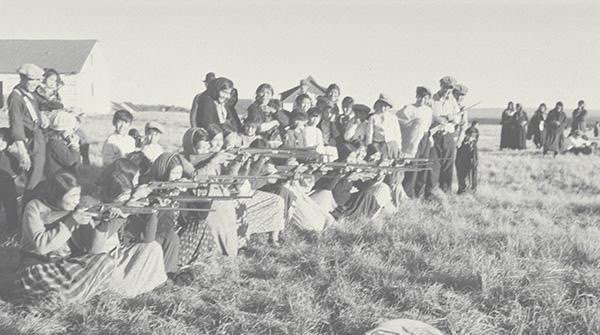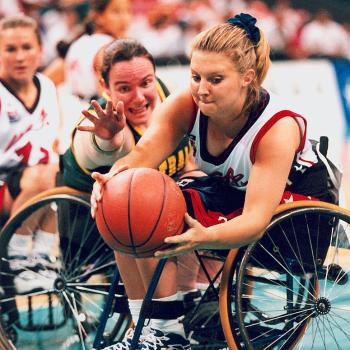So this was my online experience of the most recent school shooting: One of my Facebook friends was providing live updates from the site, relayed from her daughter who was getting the news from friends at the school. Meanwhile, three other of my Facebook friends, from three different parts of the US, were providing updates from their on-going efforts to get their children’s schools to finally do something about their kids being bullied.
It was surreal and depressing and has made me quite cynical about the US’s ability to deal with violence.
Still, we keep at it. To that end, John Hathaway’s got a good initial look at how gun deaths stack up with gun laws. The data, combined with a study of the polemics on this issue, best support the Babylon Bee’s analysis of the gun control debate. I live in Gunlandia, I can assure you the bit about Cousin Cletus is absolutely true.
One thing that is helpful in understanding the sprawling nature of the “gun violence” problem is to look at a detailed sample of the kinds of violence that are occurring. This list from Aleteia of January and early-February shootings at schools around the US provides a sampling of just how complex the situation is. There is no silver bullet solution to the gun-violence problem, regardless of whether your idea of what to do with that silver bullet is to ban it or stock up for the apocalypse.
Let’s take the data apart.
Problem #1: Suicides
Two of the school shootings on Aleteia’s list were apparent suicides (one child, one adult, in separate incidents). Most suicides this January were carried out someplace other than a school.
I’ve written before on the epidemic of suicide among American teenagers. Friends in other countries where guns are strictly controlled assure us that the bans have virtually eliminating suicide by firearms — and in fact the only cases where you hear of such suicides involve people with exceptional access to guns, such as farmers. With suicide, however, the goal is not to prevent only gun-related deaths, but to prevent people from killing themselves in general.
Here are the Wikipedia statistics on suicide rates by country.
Noteable among the wealthy, industrialized nations is how high Japan figures on the list. Belgium is a couple notches yet higher, which is not surprising given that the country has lately been enshrining suicide in the law as a sacred right and duty for those who can’t keep up anymore.
For the purpose of understanding the impact of gun laws, the most interesting comparison is between the US and France, whose rates are quite close to each other, 12.6 and 12.3 suicides per 100,000 respectively.
Another benchmark nation would be Ireland, which my friend in Dublin assures me is more or less a gun-free haven. You can read a summary of Ireland’s firearms laws and legislation here. At 11.1 suicides per 100,000 persons, the ban might be helping. In 2013 the suicide rate was 17.1 deaths per 100,000.
I think this sampling of statistics and a review of the overall distribution of suicide rates tells us a few things:
- Suicide has a strong cultural component.
- Making it more difficult to commit suicide may help somewhat. Certainly I oppose legalized euthanasia for just that reason.
- There is something else going on here.
The Eastern Mediterranean as a region, for example, has the lowest regional suicide rate. Eastern Europe appears to have one of the highest. It is difficult to believe firearms laws are the driving factor in that spread.
Based on this quick look at the data, I would hazard that if we wanted to reduce suicides in the United States, cultural changes would be far more important than firearms laws. By that I mean not just mental health care (very important), but also little things like school principals who give a rip about whether your kid is being bullied, and state laws that don’t enshrine the “you’re better off dead” ethic for the sick and disabled.
Problems #2 & 3: Vengeance & Brawling
Of the shootings on Aleteia’s list, six of them fit the friends-and-enemies profile. It’s a complicated category, composed of two distinct but interrelated types of behavior. One is shootings related to asserting gang territory and power, including settling scores, and the other is getting spitting mad at a person you know and usually love. The skill of the shooter tends to determine whether the actual person killed is the target or an innocent bystander.
In both cases, two factors play a significant role:
- Murder is culturally accepted as a way to handle the conflict.
- The killer is able to carry out the murder.
Gun laws facilitate or hinder the latter factor.
We can expect very little change in gang-related shootings with stricter gun laws, since there is no reason to believe gangs will stop having access to guns. A look at the rates of gun violence by state is informative here, specifically comparing the rate of deaths in Washington, DC to surrounding Maryland and Virginia. Guns in DC are presumed to come primarily from either Maryland or Virginia, meaning that criminals in DC live by Maryland or Virginia law, but non-criminals mostly live under a ban.
DC’s murder rate cannot be explained solely on the basis of “innocent people getting shot by criminals.” The number is too astronomically high. Something else is going on.
It seems that reducing crime and gang activity in general would be more effective at lowering DC-style violence than specifically outlawing guns.
In contrast, shootings among otherwise non-criminal hotheads who get in fights with their friends and relatives might be reduced by stricter gun laws, but only if you can persuade those hotheads to give up their guns. There is evidence that might be more difficult than you imagine.
Problem #4: Accidental Shootings
At least three of the shootings on Aleteia’s list were accidental. Honestly I have my doubts about how one could accidentally shoot five people, but we’ll trust the police report on this one. In contrast: Don’t trust that police officer whose awareness of his or her weapon was so weak a third-grader was able to reach a finger up into the officer’s holster and pull the trigger.
Gun accidents are not unlike accidental drownings (the leading cause of death for children ages 1-4), in that a combination of restricted access and safety training are both needed.
Balanced liability laws, along the lines of liability for pool owners, might be helpful. Gun owners who are patently negligent in preventing unauthorized users from accessing their guns should be held responsible for that, same as pool owners are expected to put up a fence around their pool.
More important though is building up a culture of responsibility concerning unauthorized and unsupervised access (which is currently lacking for both guns and pools). Another mom and I bonded once over our mutual “paranoia” about kids and pools, which isn’t paranoia since I really did have to fish my would-have-drowned child out of the pool, right under the nose of an oblivious lifeguard — and yet we get treated as the uptight mothers because we are active and concerned about pool safety.
Gun culture has the same problem: Gunlandians are naturally a less risk-averse population, and so obsessive attention to gun safety is not a cultural norm. That needs to change. How can the average American help? By protesting the shameful way that movies and television show supposed experts (police, for example) practicing terrible gun safety habits as a matter of course.
I’m not speaking here of anything elaborate or complicated. The big three in gun safety go a long ways in preventing accidental shootings:
- Always treat the gun as if it’s loaded.
- Don’t point the gun at anything you don’t intend to shoot.
- Keep your finger off the trigger until you are ready to shoot.
These are not complicated things. It tells on actors and directors when they don’t follow these rules — either they don’t know their character’s world, or they just don’t care.
Not caring isn’t an option. Given that at least one of the three accidental shootings on the January school shooting list involved a police officer’s weapon, simply deciding that civilians shouldn’t have guns won’t eradicate the problem.
Problem #5: Crazy Violent People
Without more details we can’t classify all the remaining shootings on Aleteia’s list, but the “crazy violent people who shouldn’t have guns” category is a factor. Two questions are: How well does our current background-checking system work, and how well should it work?
In the Sutherland Springs, TX, mass shooting, the Air Force concedes it simply didn’t participate in the background-checking system. The Parkland, FL, shooting points to a different problem: Here’s a gun buyer who passed the background check even though his peers, educators, and local police knew very well that he shouldn’t.
A background-checking system that takes into account juvenile offenses and reports that don’t lead to an arrest or conviction is rife with potential for abuse. It’s easy enough for a disgruntled neighbor or estranged spouse to make false accusations just to hinder someone’s civil rights. In the case of domestic violence this could get quite dangerous: Imagine being in the situation where your abusive ex- has falsely reported you for domestic violence or mental illness in an effort to ensure you are unable to defend yourself against a planned attack. Those who have been unjustly accused or suspected of child endangerment know how difficult it is to clear your name and resume normal life even when the local social worker isn’t on a power trip.
Likewise, Americans are understandably wary of normalizing a system where neighbors are encouraged to report your every suspicious deed to the authorities, for inclusion in your “security file.”
And yet we know that people often decline to report clear signs of abuse or neglect, and in the Parkland case, even though the signs were reported, it failed to trigger a caution on the shooter’s background-check.
It seems like some kind of middle-ground system might be a possibility, and here I’m only thinking aloud, because the civil liberties concerns are significant. But for example a yellow-light option might be useful, in which someone with a number of near-misses in the violence-and-craziness department might have a caution signalling the need for further investigation. Perhaps at that point the gun dealer, who has the competing incentives to both make the sale and to avoid selling to a violent offender, could consult with local authorities and have someone take a look and see just how steep the case against the buyer is.
That of course requires commons sense and good judgement, and risks becoming a massive game of power politics.
Likewise, Americans understandably wish to retain the option of private sales. We certainly possess the technological wherewithal to make access to a background-checking system feasible for individuals. Again there are civil liberty and privacy concerns, but given that it is already possible to request criminal background checks on your neighbors (for a fee, typically), we may be already past the point of no return on that worry.
Problem #6: What About Psychotropic Drugs?
At every mass shooting the specter of drug-induced violence is again raised. Given that wanting to harm yourself or others is a side effect nobody deserves to experience, it seems that unbiased, well-designed studies to examine the question of side effects of psychiatric medications are long overdue.
Related:
- Death & Dread – Links and Comments
- When Warfare Doesn’t Work
- Child Welfare and State Supervision of Homeschools
- Spiritual Apathy and the War on Terror
- Generation Bodies-R-Us
- Parsing the Data on “Childhood Gun Violence”
- Three Reasons Not to Own a Gun, and a Fourth I’ll Concede

Photo courtesy of Wikimedia [public domain]












